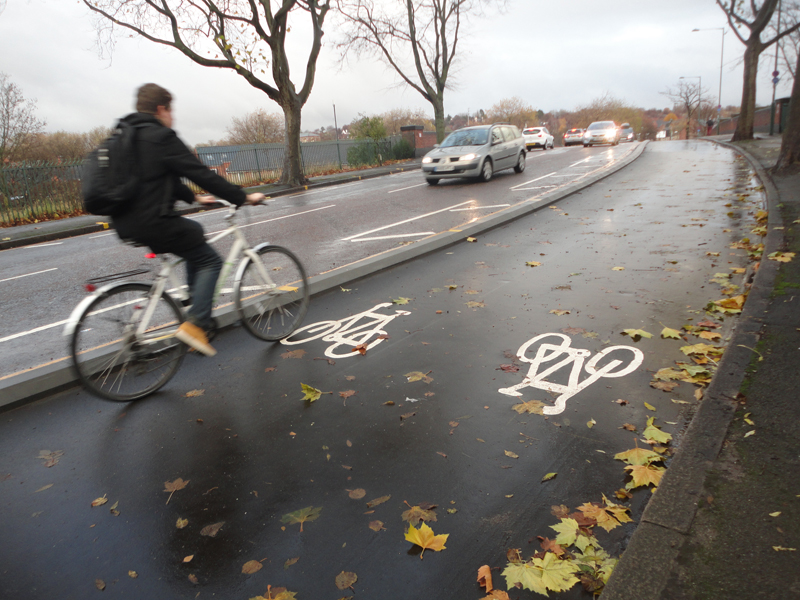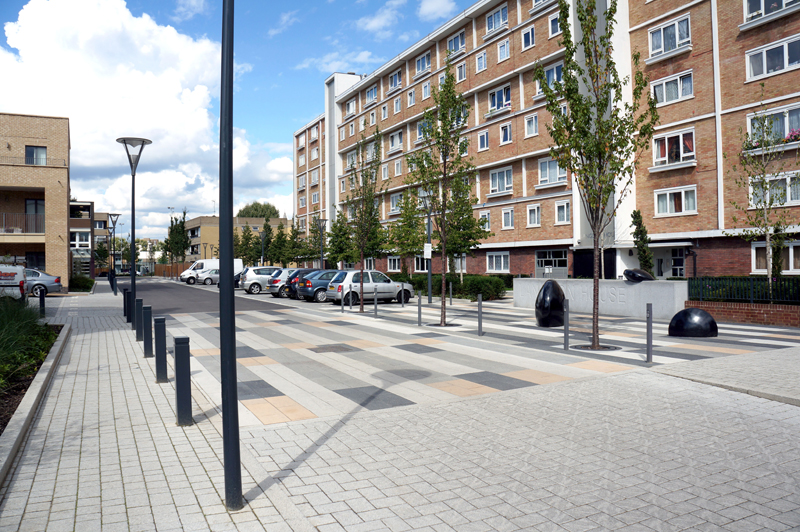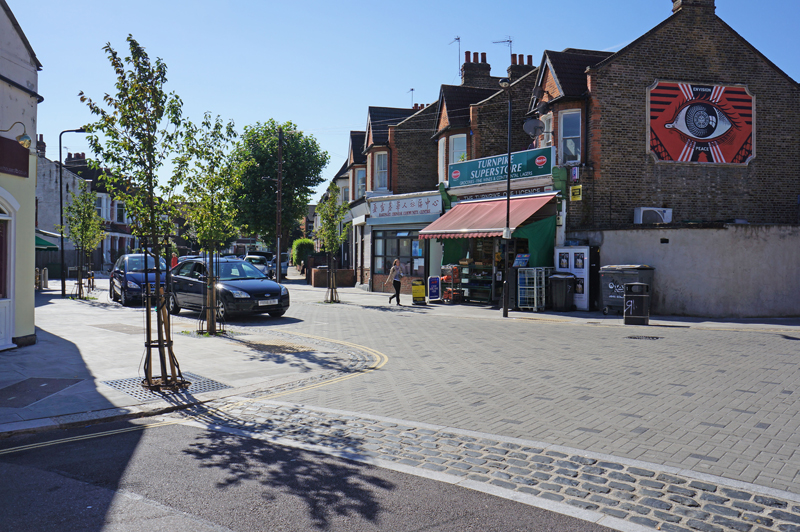Announced in May, the government’s post-pandemic investment package for cycling and walking provides a unique opportunity to transform the streets and public spaces of our towns and cities.
Established and innovative new techniques – using modular concrete paving systems – offer adaptable, low-intervention, retrofit solutions to these new challenges, demonstrated in case studies from the trade association Interpave, via www.paving.org.uk. They also address other key issues such as flooding, vehicular pollution, urban heat island effects, climate change, introduction of trees and the reinvention of our high streets.
The government’s £2bn package recognises ‘a once in a generation opportunity to deliver a lasting transformative change in how we make short journeys in our towns and cities’. The government now expects ‘local authorities to make significant changes to their road layouts to give more space to cyclists and pedestrians’. Although responding to the need for more space and increased fitness resulting from the COVID-19 crisis, this is also an opportunity to address other long-outstanding public realm issues.
Local authorities are acting quickly and temporary measures for cyclists and social-distancing pedestrians are already in place with cones, barriers and signage. But, inevitably, these measures are far from ideal. For example, upstand kerbs running along the centre of the widened footway are an impediment to pushchair and wheelchair users. There is also real uncertainty about what final form the paved environment should take, with new proposals still emerging, such as pubs and cafes making use of pavements for seating, requiring greater width.
Low cost limited intervention
Understandably, local authorities may feel reluctant to commit to expensive and disruptive permanent improvements yet and these may be expected to take some time – perhaps years. And during this time, temporary measures may well fail or cause problems. But there is an alternative approach. Adopting the principles of ‘modern methods of construction’, factory-produced modular concrete paving and kerb units deliver fast, low cost, retrofit installation with limited intervention work. Then, layouts can easily be altered and units taken up and re-used, if needed to meet changing needs.
 This approach is exemplified by recently developed cycleway segregation kerbs with special cycle-safe profiles. A fresh approach to retrofit kerb installation involves cutting and removing the carriageway surface course only, to suit the kerb footprint. Then, the kerb units are simply laid onto a high strength bedding mortar on the existing road base and secured with steel dowels through preformed holes. installation time for construction of a cycle route was lowered by 50%, also reducing costs, traffic management, congestion and exposure of the workforce to in situ risks. Alterations to meet changing needs can easily be carried out re-using the same products.
This approach is exemplified by recently developed cycleway segregation kerbs with special cycle-safe profiles. A fresh approach to retrofit kerb installation involves cutting and removing the carriageway surface course only, to suit the kerb footprint. Then, the kerb units are simply laid onto a high strength bedding mortar on the existing road base and secured with steel dowels through preformed holes. installation time for construction of a cycle route was lowered by 50%, also reducing costs, traffic management, congestion and exposure of the workforce to in situ risks. Alterations to meet changing needs can easily be carried out re-using the same products.
Paving by design
The same principles apply to all precast concrete block, flag and kerb products. They are fully engineered and manufactured under sustainable, controlled conditions – consistently providing accurate sizes, colours and textures, as well as slip/skid resistance and other performance characteristics. The distinct, modular units and designed variations in colour, texture and shape can break up areas giving visual interest and a human scale not possible with monotonous, formless materials. So, precast concrete paving offers a unique combination of predictability, safety and accessibility for all, with scope for endless variety in shape, scale, colour and texture to enrich the urban environment.
 One exemplar of inspired design enhancing the urban realm is the regeneration of the Brownfield Estate in east London, incorporating interventions with concrete block and flag paving. This clearly defines footways and defensible space, as well as highlighting new public spaces to give a sense of arrival. New ‘Plazas’ now announce block entrances, with strong-coloured concrete flag linear paving, and these out as level shared surfaces right across the adopted street itself.
One exemplar of inspired design enhancing the urban realm is the regeneration of the Brownfield Estate in east London, incorporating interventions with concrete block and flag paving. This clearly defines footways and defensible space, as well as highlighting new public spaces to give a sense of arrival. New ‘Plazas’ now announce block entrances, with strong-coloured concrete flag linear paving, and these out as level shared surfaces right across the adopted street itself.
Improving Streets
Good paving design helps create ‘places for people’ and attractive spaces will help encourage walking and cycling. It is also central to the rejuvenation of our high streets, as part of their reinvention with the demise of town centre shopping. And it applies equally to our residential streets as well.
Community-led neighbourhood improvements near Turnpike Lane, London, highlight concrete block paving interventions to limit traffic and encourage social interaction. A joint initiative between Haringey Council and Sustrans, the project delivers long-lasting improvements to an established residential area. Here, concrete block paving with a restrained palette of colours and styles establishes local character and influences the way that drivers behave.
 Low-intervention techniques employed include widening footways coupled with traffic calming measures such as road narrowings and raised junctions. All of these interventions can be easily and sustainably altered and modular paving components re-used to meet future changes.
Low-intervention techniques employed include widening footways coupled with traffic calming measures such as road narrowings and raised junctions. All of these interventions can be easily and sustainably altered and modular paving components re-used to meet future changes.
Sustainable Drainage
An additional, key consideration is storm-water flood prevention, particularly with climate change, and concrete block permeable paving is uniquely placed as an essential, multifunctional sustainable drainage (SuDS) technique. In additions to paving, it also provides an inherent drainage system that requires no additional land take for water storage, treatment or conveyance. This technology eliminates pipework, gulleys and manholes, and generally costs less than conventional drainage and paving.
But equally important to flooding is the long- and short-term damage caused by pollutants in surface water runoff to the biodiversity and health of our rivers and streams. The Greater London Authority ‘Road Runoff Water Quality Study’ (December 2019) concludes that ‘London’s roads are harming London’s rivers’ and proposes SuDS features to manage runoff pollution from the most damaging roads. Here, concrete block permeable paving offers a real opportunity to address this major problem by trapping vehicle pollution.
At the same time, permeable paving can provide a completely level, well-drained, firm and slip-resistance surface accessible to all, without the need for cross-falls, channels, gulleys or other interruptions. Rainwater ‘ponding’ is eliminated, reducing the risk of ice forming on the surface and preventing splashing from standing water. It also allows water to reach tree and shrub roots, despite providing a hard surface above: the Code of Practice for accessibility in the external environment, BS 8300-1:2018, calls for permeable paving instead of tree grilles. Permeable paving can also help reduce the urban heat island effect, with evaporation of rainwater within the paving. This is in addition to the high albedo – or heat reflectance factor – offered by concrete block or flag paving generally, compared with asphalt.
Retrofit permeable paving overlay
An award-winning, exemplary SuDS scheme near Australia Road, London, (pictured above) demonstrates the multifunctional benefits of retrofitting permeable paving in place of conventional street surfaces. Its design, by Robert Bray Associates, introduces the innovative concept of concrete block permeable paving as a thin overlay for existing streets, removing rainwater straight from the surface without gulleys and providing attenuation and treatment before discharging to adjacent, well-planted basins.
The concrete block permeable paving overlay simply replaces a tarmac road surface over the original road base. The same blocks and 2-6mm grit bedding layer and jointing material as used in CBPP generally are here installed on an impermeable membrane covering the road base. Water is attenuated to some extent and pollutants removed within the paving, then released horizontally via the stainless-steel letterbox slots into the planted basins.
The innovative concept of concrete block permeable paving overlays to existing streets opens up wider possibilities for pedestrian areas, shared surfaces, widened footways, cycleways, bus lanes and carriageways. With good design, this straightforward solution can meet government requirements to encourage walking, cycling and social distancing – with minimal interventions and maximum flexibility – whilst reducing flooding, pollution and overheating. This technology has already been used for temporary overlays to existing streets to provide a well-drained surface level with the footway during short-term pedestrian trafficking.
Chris Hodson is an architect and consultant to Interpave












